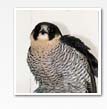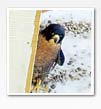Educational Programs
Bird of Prey Conservation through Education,
Field Study and Wise Stewardship
In the spring of 2000 Manitoba’s School Science
Advisors were presented with a proposal for students to become personally
engaged with one of Canada’s most rare and exciting species.
With the support of the Science Advisors, Parkland
Mews is pleased to offer teachers a truly stimulating learning experience
for their students to interact with an Endangered Peregrine Falcon.
Areas most suited for the Peregrine Falcon as part of the Manitoba
elementary school science curriculum are listed below.
Lesson plans prepared by Parkland Mews are in module
form. Depending on classroom requirements either single learning
outcomes, or multiple learning outcomes are provided to assist teachers
in meeting their objectives.
Grade 1 - Characteristics and Needs of Living
Things
- 1-1-03 Identify and describe common characteristics
of humans and other animals they have observed.
- 1-1-07 Recognize that plants, animals, and humans,
as living things, have particular needs.
- 1-1-08 Describe what is needed to care for a pet,
a farm animal, or an indoor plant.
- 1-1-09 Compare ways in which humans and other
animals meet their needs.
- 1-1-10 Describe how humans and other living things
depend on their environment to meet their needs.
- 1-1-12 Identify hobbies and jobs that require
knowledge of the needs of living things.
Grade 2 - Growth and Changes in Animals:
- 2-1-09 Compare the appearance of young and mature
animals of the same type.
- 2-1-11 Identify and describe constant and changing
characteristics of an animal as it grows and develops.
- 2-1-13 Describe and compare ways in which different
animals care for their offspring.
- 2-1-14 Describe changes in the appearance and activity
of various animals as they go through a complete life cycle.
- 2-1-15 Compare the life cycles of animals that
have similar life cycles and those that have different life cycles.
- 2-1-16 Observe and describe an animal’s life
processes.
- 2-1-17 Identify and describe ways in which humans
help other animals.
Grade 4 - Habitats and Communities:
- 4-1-02 Recognize that each plant and animal depends
on a specific habitat to meet its needs.
- 4-1-03 Identify the components of an animal habitat.
- 4-1-04 Identify physical and behavioural adaptations
of animals and plants, and infer how these adaptations help them
to survive in a specific habitat.
- 4-1-09 Recognize that plant and animal populations
interact within a community.
- 4-1-10 Recognize that the food chain is a system
in which some of the energy from the sun is transferred eventually
to animals.
- 4-1-13 Predict, based on their investigations,
how the removal of a plant or animal population may affect the
rest of the community.
- 4-1-14 Investigate natural and human-caused changes
to habitats, and identify resulting effects on plant and animal
populations.
- 4-1-16 Describe how specific technological developments
have enabled humans to increase their knowledge about plant and
animal populations.
Grade 6 - Flight:
- 6-2-03 Identify adaptations that enable living
things to propel themselves through air, water, or to be transported
by the wind.
- 6-2-05 Describe how “lighter-that-air flying
devices” are able to achieve lift.
- 6-2-08 Provide examples of design features or adaptations
that enhance or reduce drag, and explain how they work.
*Presentation Fees are $2.50 per student.
Individual class sizes are preferred.
Robert Wheeldon has spent many years in both Canada
and New Zealand as a professional wildlife educator and falconer.
His bird of prey presentations are a popular choice for the annual
day camps at the Fort Whyte Nature Centre each summer. Robert's
most recent work is the authorship of a Recovery Plan and a Recovery
Strategy for the Peregrine Falcon in Manitoba, and was undertaken
at the request of the provincial government.
*Prices subject to increase.
For
additional information on Parkland Mews' Live demonstrations and
presentations, please click here.
|

